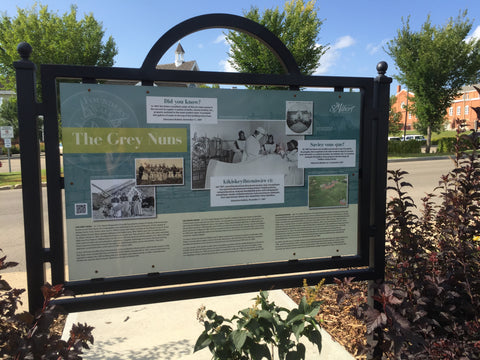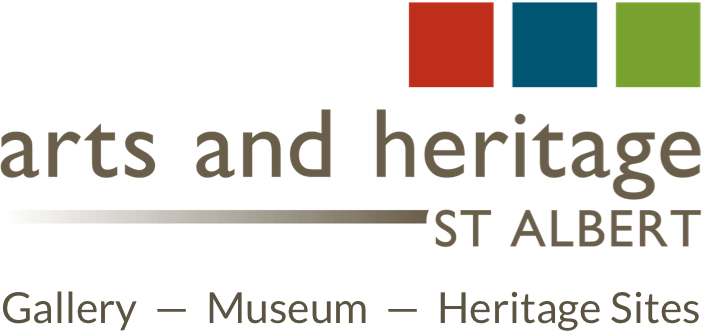
ONLINE EXHIBITION
14. The Grey Nuns
The Grey Nuns
In 1737, Marie-Marguerite d’Youville founded the Sisters of Charity of Montreal. They became known as the Grey Nuns, due to their grey habits, black capes and bonnets. Three Sisters came west in 1859 to work with Father Lacombe at the Mission at Lac St. Anne: Zoé Leblanc-Emery, Marie Jacques-Alphonse and Adèle Lamy.
After Father Lacombe founded the new St. Albert mission in 1861, he asked the three nuns to join him. They arrived in 1863, with seven orphaned Métis and First Nations children from Lac Ste. Anne. The Grey Nuns served the people of St. Albert through their work in health care and education, operating a hospital, orphanage and school. The hard working Sisters became well known around the region as skilled bonesetters, nurses and dentists. They also operated a productive farm, which grew to 900 acres by 1898.
In the 1890s the Youville Industrial School became part of the residential school system until it closed in 1948. The Sisters then turned their focus to the care of the elderly and infirmed. In 1967 a new seniors home was opened to replace the 1909 building that was still being used. Most recently, in 2006, a beautiful new facility was opened, still serving St. Albert from its site on Mission Hill.
– Edmonton Bulletin, November 11, 1897
En 1737, Marie-Marguerite d’Youville a fondé les Soeurs de Charité de Montréal. Connue aussi sous le nom de “les Soeurs Grises” la congregation se consacrait au service des pauvres. A la demande de l’Evêque Taché trois soeurs, Zoé Leblanc-Emery, Marie Jacques-Alphonse et Adèle Lamy sont venues dans l’ouest en 1859 travailler avec le Père Lacombe à la mission du lac St-Anne. Suivant la foundation de la mission de St Albert en 1861, le Père Lacombe a invité les trois soeurs à le rejoindre. Elles sont arrives en 1863 avec sept orphelins métis et de Premières Nations du Lac Ste-Anne. Le couvent a été utilisé comme orphelinat, école et hôpital.
Les Soeurs Grises ont servi les habitants de St-Albert à travers leurs travaux en santé et en éducation. Elles étaient connues dans la région comme étant des rebouteuses, des infirmières et des dentistes. Ces soeurs travailleuses opéraient aussi une ferme productive qui s’est étendue jusqu’à 900 acres en 1898.
Lors des années 1870, l’école Youville School s’est jointe au système d’école résidentiel jusqu’à sa fermeture en 1948. Par la suite, les Soeurs Grises ont concentré leurs efforts sur la santé des personnes âgées et des infirmes de St-Albert. En 1967, un nouvel édifice a remplacé le centre de 1909. Plus récemment, en 2006, un magnifique centre a ouvert les portes pour servir la communauté de St-Albert sur la colline Mission Hill.
– Edmonton Bulletin, le 11 novembre 1897
ispî 1737, Marie-Marguerite d’Youville kîmâcitâwâk Sisters of Charity ohci Montreal. kînistawêyihtâkosiwak isih ayamihêwiskwêwak, mâmawi nîsôhkamêwak kawîcihâcik okitimâkisowa. Bishop Taché nitotamâw, nisto ayamihêwiskwêwâk kapê takosiniyit ôtê pahkisimotâhk ispî 1859 kawîcihatoskêmâcik Father Lacombe anita ayamihêwînînâhk Lac St. Anne: Zoè Leblanc-Emery, Marie Jacques-Alphonse êkwa Adèle Lamy.
mwêstas Father Lacombe mâcihtâw ôma oskâyi St. Albert ayamihêwînînâhk ispî 1861, êkwa wîsâmêw ôhi nisto ayamihêwiskwêwa kapênîsôhkamâkot. êhitakosihkik 1863, kîpêkikîwak têpakohp kîwâc awâsisak otipêyimisiwak êkwa iyiniw kêwâcawâsisak Lac Ste. Anne ohci. ayamihêwiskwêwak wîcihêwâk ayisiyiniwak ohci St. Albert êhatoskâtahkik âhkosiwin êkwa kiskinohamâkosiwin, pimipayihtâwak âhkosîwikamik, kîwâtisowikamik êkwa kiskinohamâkosiwin. ôki kâsohkihatoskêcik ayamihêwiskwêwak nistawêyimêwak isîh omînoniwêwa, maskihkîwiskwêwak êkwa mîpitomaskihkîwiyiniwa. kîkistikêwak kêkâmitâtahtwâw mitâtahtomitanaw kâhkatikwanâskiy ispî 1898.
ispî 1890s, Youville Industrial School kîwîtâpisômêwak ôhi kâwîkihk kiskinohamâtowikamikwa isko kâkipahikâtêk ispî 1948. ayamihêwiskwêwak mêskoc nakatêyimêwak kêhtêhayahk êkwa kânêsowâtisicik. nânitaw 1967, kiyohtênamwak oskâyi kêhtêyaw’kamik kamêskotastahcik 1909 wâskahikan kêyâpic kâkîhapacihtâcik. âstamispî, ispî 2006, êmiywâsik wâskahikan kîyôtênikâtêw, kêyâpic êhâpatahk St. Albert ohci Mission Hill.
– Edmonton Bulletin, November 11, 1897



